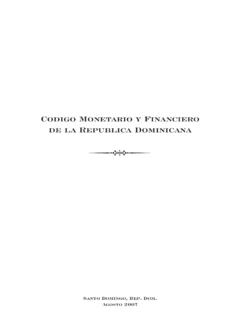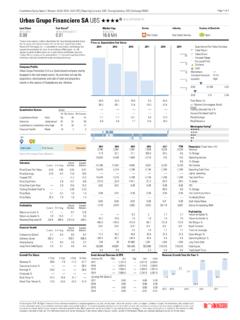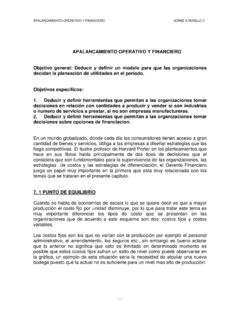Transcription of OECD Economic Surveys Luxembourg
1 OECD Economic Surveys Luxembourg March 2015 OVERVIEW This work is published under the responsibility of the Secretary-General of the OECD. Theopinions expressed and arguments employed herein do not necessarily reflect the officialviews of OECD member document and any map included herein are without prejudice to the status of orsovereignty over any territory, to the delimitation of international frontiers and boundariesand to the name of any territory, city or 978-92-64-23065-1 (print)ISBN 978-92-64-23066-8 (PDF)Series: OECD Economic SurveysISSN 0376-6438 (print)ISSN 1609-7513 (online)OECD Economic Surveys : LuxembourgISSN 1995-3720 (print)ISSN 1999-0782 (online)The statistical data for Israel are supplied by and under the responsibility of the relevant Israeli authorities.
2 The useof such data by the OECD is without prejudice to the status of the Golan Heights, East Jerusalem and Israelisettlements in the West Bank under the terms of international credits:Cover to OECD publications may be found on line OECD 2015 You can copy, download or print OECD content for your own use, and you can include excerpts from OECD publications, databases andmultimedia products in your own documents, presentations, blogs, websites and teaching materials, provided that suitableacknowledgement of OECD as source and copyright owner is given. All requests for public or commercial use and translation rights shouldbe submitted Requests for permission to photocopy portions of this material for public or commercial use shall beaddressed directly to the Copyright Clearance Center (CCC) the Centre fran ais d exploitation du droit de copie cite this publication as:OECD (2015),OECD Economic Surveys : Luxembourg 2015, OECD Publishing, Economic Surveys : Luxembourg OECD 201511 Executive summary Main findings Key recommendations OECD 20151 EXECUTIVE SUMMARYOECD Economic Surveys : Luxembourg OECD 201512 Main findingsLuxembourg is one of the most prosperous countries in the OECD with very high levels ofwell-being, particularly incomes.
3 The economy, including its financial sector, has weatheredthe crisis well, growth has picked up, supported by sound macroeconomic the financial s large financial sector still playsa pivotal role, although its share in total output has fallen. Product diversification intoinvestment funds, wealth management and insurance is continuing. However, changingfinancial market regulation in Europe, increased international transparency requirementsfor banking and heightened international competition pose challenges. Furtherdiversification of the financial sector into new areas requires investors trust in regulatorssafeguarding financial market stability. Nevertheless, the financial sector might havereached a size where its contribution to GDP growth might fade, and high dependence onone sector poses medium-term productivity and diversifying the Economic outputgrowth has slowed significantly in recent years, reflecting rising structural unemploymentand declining trend productivity growth.
4 Private spending on research and development(R&D) is low and falling, although public R&D spending has been boosted. The secondaryeducation system is hampered by high repetition rates of students; female labour forceparticipation, although it increased, is still low. Enterprise clusters do not yet fully exploitpotential benefits from cooperation between enterprises and research fiscal fiscal position is strong, and the main fiscalchallenges are age-related spending, which is projected to rise by about percentagepoints of GDP by 2030. There is some uncertainty surrounding financial-sector taxrevenues, which can be subject to large fluctuations due to financial market volatility. OECD 20152 EXECUTIVE SUMMARYOECD Economic Surveys : Luxembourg OECD 201513 Key recommendationsStrengthening the performance of the financial sector Continue to monitor financial market risk while using a comprehensive approach to riskassessment that accounts for financial linkages between banks and non-bank financialintermediaries, notably investment funds.
5 Continue efforts to develop resolution plansand to undertake resolvability assessments so that important banks could be resolvedeffectively across borders. For this end, continue to cooperate with regulatory authoritiesin other jurisdictions outside the productivity and diversifying the Economic base Better evaluate the effectiveness of public R&D spending and cluster policies. Strengthen the cooperation between enterprises, University of Luxembourg andresearch institutions in Luxembourg and abroad. In secondary education, reduce grade repetition, provide more school autonomy andbetter monitor education growth To reduce carbon emission, continue substantial investment in public transportinfrastructure, using the receipts from fuel taxation for this purpose. Explore theintroduction of a system of congestion charges.
6 Increase taxes on petrol and diesel togradually eliminate price differentials with neighbouring fiscal pressures Strengthen fiscal planning by introducing a spending review mechanism and link it tothe medium-term budgeting framework. Consider introducing a spending ceiling for thegeneral government. Continue to actively participate in international negotiations on co-ordinated action tocombat tax base erosion and profit shifting of multinational enterprises, includingaction to prevent double non-taxation. Change domestic laws if necessary. OECD 20153 OECD Economic Surveys : Luxembourg OECD 201515 Assessment and recommendations Macroeconomic outlook Strengthening the performance and resilience of the financial sector Fostering the emergence of innovative industries Greening growth OECD 20154 ASSESSMENT AND RECOMMENDATIONSOECD Economic Surveys : Luxembourg OECD 201516In the two decades prior to the crisis, Luxembourg grew twice as fast as the Europeanaverage and per capita incomes climbed to one of the highest in the OECD area (Figure 1).
7 Non-residents account for a large share of the economy s employment. Thus, gross nationalincome (GNI), which excludes factor income from domestic production that accrues to non-residents, undercuts gross domestic product (GDP) by about a third. Nonetheless, even ifaggregate income per capita is measured by GNI rather than GDP Luxembourg still ranks atthe top of the OECD, surpassed only by Norway. Growth has also enhanced exceeds the OECD average in most dimensions of the OECD s well-being indexby a significant margin (Figure 2). Specialisation in fast growing, high-value-added servicesectors, notably financial and related services, transformed a steel producing economy to amajor financial centre. This transformation was facilitated by financial sector liberalisationand early adoption of a number of EU financial services directives.
8 Luxembourg is anattractive business location reflecting its regulatory and tax systems, sound macroeconomicpolicies and openness to skilled workers from other , the economy depends heavily on its financial sector, creating potentialvulnerabilities, and the sector s contribution to the economy s growth might diminish. Atthe same time, labour productivity growth has trended down. Unemployment amonglower skilled is relatively high reflecting challenges in the education and training raise productivity and potential growth, the economy should diversify towards suchFigure in GDP per capita in the 10 OECD economies with the highest GDPNote:Simple average of the 10 OECD countries with the highest GDP per capita (in constant 2005 PPPs) in : OECD Economic Department 2 ,00020,00030,00040,00050,00060,00070,000 80,0001990919293949596979899200001020304 0506070809101112 USD, constant 2005 PPPReal GDP per capita, LUXReal GDP per capita, 10 highest economies OECD 20155 ASSESSMENT AND RECOMMENDATIONSOECD Economic Surveys : Luxembourg OECD 201517activities as R&D, product design or marketing (OECD, 2013a).
9 The key messages from theSurveyare: Investors trust in financial market stability is key to the financial sector. Diversifying the economy would help to keep Luxembourg s living standards high. On unchanged policies, ageing-related government spending would steeply outlookRecent Economic developmentsEconomic growth slowed in the course of 2014, but it remained significantly higherthan the euro area average (Figure 3). Growth is benefiting from resilient domestic demandand robust activity in the mutual fund industry. However, unemployment has continued torise, to at end-2014, youth unemployment (15 to 24 year-old) has drifted up to above15% in the first three quarters of 2014, and the share of the long-term unemployed(unemployed for a year or more) to more than 25% of total unemployment.
10 Youthunemployment (relative to the labour force of the 15 to 24 year-old) exceeded 30% at theend of 2014 ( of all persons aged 15-24 in 2012). New OECD estimates suggest that morethan 80% of unemployment is structural, although structural unemployment, as well aspotential output, is difficult to estimate in such a small open economy with a high share ofcross-border workers and a large financial s external position is strong, with a persistent current account surplusand a net international asset position of 216% of GDP (Figure 4). The surplus, which hasfallen from around 10% of GDP prior to the crisis to about 5% since, is entirely attributableto sustained services exports, mainly financial outcomes: Better Life Index201411. Each well-being dimension is measured by one to four indicators from the OECD Better Life Index set.
















